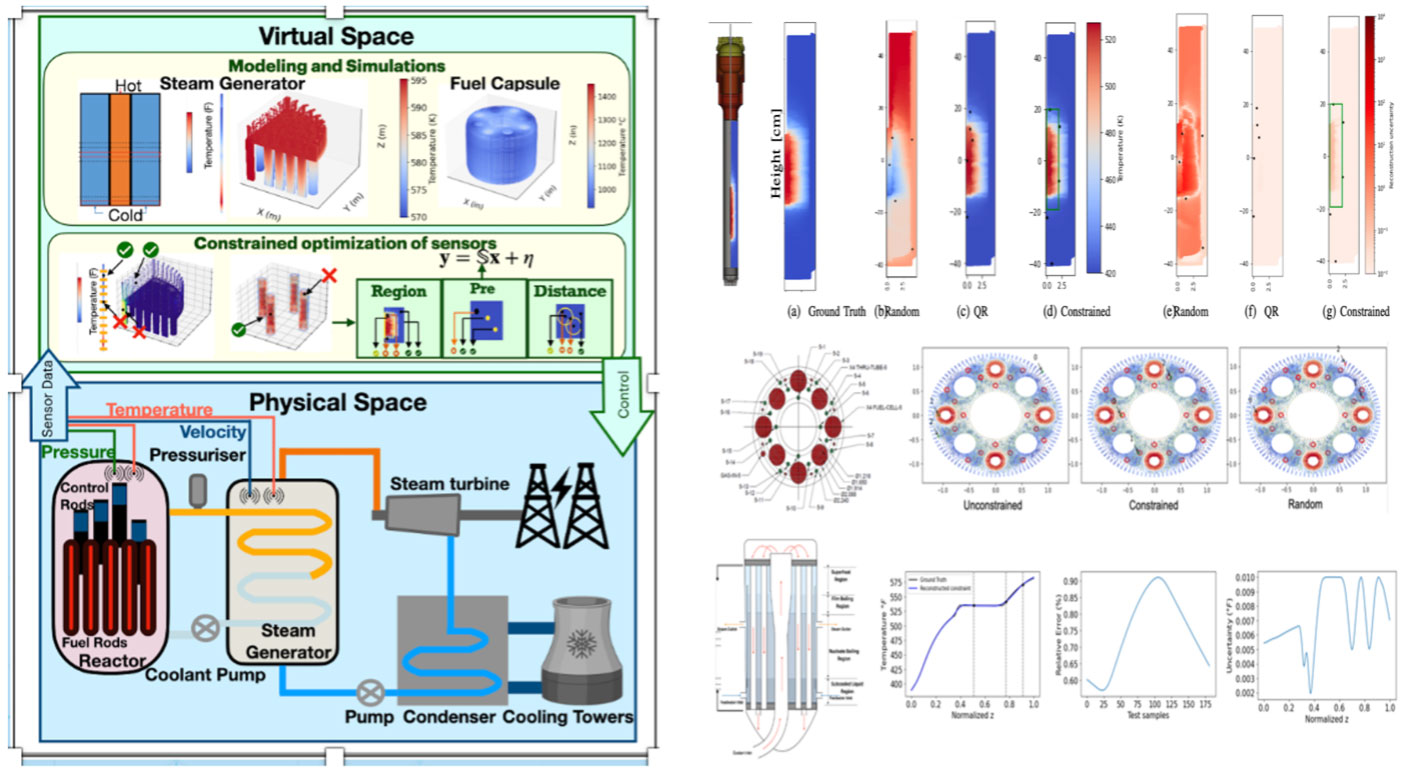Laboratory Directed Research and Development (LDRD)
Benefits of LDRD
The LDRD program proves its benefit each year through new programs, intellectual property, patents, copyrights, national and international awards and publications. It also provides a means to feed the pipeline with scientists and engineers through undergraduate and graduate internships, postdoctoral assignments and internal PhD candidates.
LDRD Success Story
Optimal sensor placement for reactor fields reconstruction enables communication among a network of nuclear digital twins
Nuclear power plants require continuous monitoring of various systems, structures, and components to ensure safe and efficient operations. Accurate reconstruction of fields of interest (e.g., temperature, pressure, velocity, etc.) from sensor measurements is crucial to establish a two-way communication between physical experiments and models. However, deploying extensive sensor arrays in nuclear reactors is infeasible due to challenging operating conditions and inherent spatial limitations. In this work, INL researchers developed a data-driven technique that incorporates constraints into an optimization framework for sensor placement. The primary objective was to minimize reconstruction errors under noisy sensor measurements.
Check out these publications for more information.
- Karnik, N., Abdo, M.G., Estrada-Perez, C.E., Yoo, J.S., Cogliati, J.J., Skifton, R.S., Calderoni, P., Brunton, S.L. and Manohar, K., “Constrained optimization of sensor placement for nuclear digital twins,” IEEE Sensors Journal, Volume 24, Issue 9, 2024.
- Karnik, N., Wang, C., Bhowmik, P. K., Cogliati, J. J., Balderrama Prieto, S. A., Xing, C., Klishin A.A., Skifton, R., Moussaoui, M., Folsom, C.P., Palmer, J.J., Sabharwall, P., Manohar, K., and Abdo, M. G., “Leveraging Optimal Sparse Sensor Placement to Aggregate a Network of Digital Twins for Nuclear Subsystems,” Energies (19961073), 17(13), 2024.
- Kim, H., Cetiner, S., and Bucci, M., “Thermal fluids field reconstruction with Bayesian inference for forced convection system,” Proceedings of 13th Nuclear Plant Instrumentation, Control and Human-Machine Interface Technologies, American Nuclear Society, NPIC and HMIT 2023 (pp. 639-648), 2023.
- Kim, H., Cetiner, M., and Bucci, M., “Inverse Problem Approach for Estimating Operating Conditions and Uncertainty Quantification in Actual Forced Convection System,” International Congress on Advances in Nuclear Power Plants (ICAPP), 2024.
Collaboration
INL’s LDRD program encourages collaboration across organizational, institutional, and geographical boundaries to advance the frontiers of science, technology, and engineering. Of the 407 researchers working on LDRD projects in fiscal year 2023, 106 of them were outside INL and represented 27 states and Canada. These external collaborators included 93 researchers from 39 universities, six researchers from national laboratories, and seven researchers from different companies.
The Center for Advanced Energy Studies and the National University Consortium facilitate collaboration with particular research universities to further INL’s mission. The Center for Advanced Energy Studies is research and education consortium consisting of INL and the public research universities of Idaho: Boise State University, Idaho State University and University of Idaho. The National University Consortium includes the partner universities Massachusetts Institute of Technology, North Carolina State University, The Ohio State University, Oregon State University and University of New Mexico. Thirty-four researchers from the consortia were co-investigators on LDRD projects in the fiscal year 2023, and many more students and postdocs.

Publications
Showcasing Success
Each year, researchers display their completed projects at the LDRD Poster Session. On August 24, 2023, nearly 60 researchers showcased their accomplishments to INL staff, Department of Energy representatives, and the general public.
On August 24, 2023, INL hosted a poster session and symposium showcasing the LDRD projects ending in fiscal year 2023. Attendees included INL researchers, industry and academic partners, external collaborators, and members of the public. Images of the posters are available on INL.gov.
Secure and Resilient Machine Learning System for Detecting Fifthgeneration Attacks including Zero-Day Attacks
The Process
The laboratory ensures that LDRD program goals and objectives are aligned with DOE Order 413.2C, Chg. 1, and that the LDRD portfolio is managed with integrity and transparency. All LDRD projects go through a rigorous proposal review and selection process, and ongoing projects applying for renewal are contingent on a progress report review. These steps ensure that LDRD investments are continually aligned with INL’s vision, mission, and S&T initiatives, and are technically sound, innovative, cutting-edge RD&D projects that comply with the LDRD Order. New project proposals and ongoing project progress reports are subject to multiple levels of review (by management, technical reviewers, and a strategic review committee).
Lab leadership establishes review committees for each focus area and for seed proposals. These committees review new project proposals and ongoing project progress reports and make funding recommendations. Committees are staffed by senior and midcareer researchers and technical managers who are subject matter experts without any conflict of interest with the proposed projects. The deputy lab director for S&T reviews the committees’ recommendations with the associate laboratory directors and makes final funding decisions on the LDRD portfolio. DOE’s Idaho Operations Office concurs on each proposed and continuing project prior to project authorization.
By the Numbers
140 active projects
$47 million total project cost
Installation of the fueled-salt
irradiation experiment at the Neutron
Radiography reactor.
Simplified Microreactor Benchmark Assessment problem overview (b) computed temperature and (c) computed
hydrogen stoichiometric ratio in the yttrium hydride
(YHx) moderator pins.
Scanning electron microscopy images showing a) complete removal of all TRISO layers showing exposed uranium fuel kernels, b) obliteration of the outer carbon and silicon carbide layers revealing the uranium fuel kernel, c) channeling through the silicon carbide and inner carbon layers to reach the uranium center.
A) Microwave digestion system; B) uranium samples dissolved using the microwave system; C) elemental recoveries for certified reference materials.
Major scientific accomplishments from this project.

